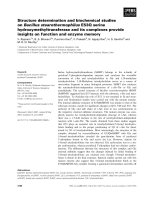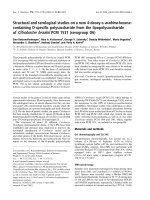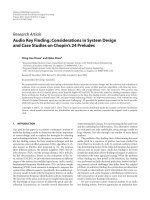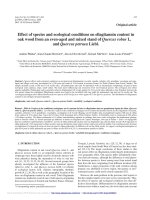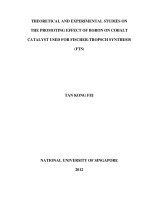Morphological, anatomical and ecological studies on Tulipa armena Boiss. var. lycica (baker) marais (liliaceae)
Bạn đang xem bản rút gọn của tài liệu. Xem và tải ngay bản đầy đủ của tài liệu tại đây (310.13 KB, 8 trang )
Turk J Bot
28 (2004) 427-434
â TĩBTAK
Research Note
Morphological, Anatomical and Ecological Studies on
Tulipa armena Boiss. var. lycica (Baker) Marais (Liliaceae)
Atila OCAK
Osmangazi University, Faculty of Science & Arts, Department of Biology, Eskiflehir - TURKEY
Sevim ALAN
Anadolu University, Faculty of Pharmacy, Pharmaceutical Botany, Eskiflehir - TURKEY
Ebru ATAfiLAR
Osmangazi University, Faculty of Science & Arts, Department of Biology, Eskiflehir - TURKEY
Received: 28.07.2002
Accepted: 28.01.2003
Abstract: This study presents investigations into the morphological, anatomical and ecological features of Tulipa armena Boiss. var.
lycica (Baker) Marais. T. armena var. lycica, an endemic species which was collected from the Eskiflehir, Alpu-Bozan plantation area
and from Kunduzlar Dam and its environs. The species is a new record for Eskiflehir. For morphological studies a description and
illustrations of T. armena var. lycica are given. The morphological differences were compared with the Flora of Turkey. For
anatomical studies, cross-sections of the root, stem and leaves and surface sections of the leaves of T. armena var. lycica are
investigated for the first time. Furthermore, for ecological investigations, the chemical and physical properties of the soil are
analysed. The climate of Eskiflehir and other climatic features are also given.
Key Words: Tulipa armena var. lycica, endemic, morphology, anatomy, ecology
Tulipa armena Boiss. var. lycica (Baker) Marais (Liliaceae) ĩzerinde
Morfolojik, Anatomik ve Ekolojik ầalflmalar
ệzet: Bu ỗalflmada Tulipa armena Boiss. var. lycica (Baker) Maraisin morfolojik, anatomik ve ekolojik ửzellikleri arafltrlmfltr.
Endemik bir tỹr olan T. armena var. lycica, Eskiflehir Alpu-Bozan aÔaỗlandrma sahasndan ve Kunduzlar Baraj ỗevresinden
toplanmfltr. Tỹr Eskiflehir iỗin yeni kayt niteliÔi taflmaktadr. T. armena var. lycicann morfolojik ửzellikleri incelenmifl ve farkllklar
Flora of Turkey ve diÔer ỗalflmalar ile karfllafltrmal olarak verilmifltir. Anatomik ỗalflmalar iỗin bitkinin kửk, gửvde, yaprak enine
kesitleri ile yaprak yỹzeysel kesitleri incelenmifl ve sonuỗlar verilmifltir. Ekolojik ỗalflmalarda T. armena var. lycicann yetifltiÔi
topraÔn kimyasal ve fiziksel ửzellikleri ile Eskiflehirin iklimsel ửzellikleri verilmifltir.
Anahtar Sửzcỹkler: T. armena var. lycica, endemik, morfoloji, anatomi, ekoloji
Introduction
The genus Tulipa L. belongs to the family Liliaceae and
is represented by 16 taxa (15 species), of which 2 are
endemic in Turkey (Davis, 1984, 1988; ệzhatay, 2000).
Tulipa armena Boiss. var. lycica (Baker) Marais is an
endemic species (Davis, 1984). T. armena var. lycica is a
new record from Eskiflehir and is a rare taxon. A
taxonomic revision of the genus Tulipa in India and
adjoining regions was performed by Dasgupta & Deb
(1985). Other investigations have been carried out into
Liliaceae and Iridaceae by ệzyurt (1978).
The genus Tulipa has attractive flowers and has been
widely used as an ornamental plant. Various local Turkish
names are used for Tulipa species. Some of these are
Tỹrk lalesi, Halep lalesi, Bodur lale, ầoban lalesi,
Amasya lalesi and Trakya lalesi (Baytop, 1994).
There have been no anatomical and ecological studies
of the Tulipa species naturally distributed in Turkey.
427
Morphological, Anatomical and Ecological Studies on Tulipa armena Boiss. var. lycica (Baker) Marais (Liliaceae)
Materials and Methods
Tulipa armena Boiss. var. lycica (Baker) Marais was
collected from the Eskiflehir, Alpu-Bozan plantation area
and from Kunduzlar Dam and its environs. Specimens for
morphological studies were dried according to standard
herbarium techniques and stored at the Osmangazi
University Herbarium (OUFE 9052). The materials
necessary for anatomical studies were preserved in 70%
alcohol.
The taxonomic description of the plant was made
according to Davis (1984) and also confirmed by the
herbarium samples of the examined species in ANK and
GAZ‹. The morphological illustrations were drawn with a
Wild M5A stereomicroscope.
Anatomical investigations were performed on the
cross-sections of the root, stem and leaves, and on the
surface sections of leaves. The cross and surface sections
were covered with glycerin-gelatin (Vardar, 1987). The
drawings were made by means of a camera lucida of a
Leitz SM-LUX binocular microscope. The photographies
were taken from Olympus CH40, diagnostic digital
camera (SPOT insight clour 3.2.0).
Soil textures were determined by the Bouyoucus
hydrometer method (Bouyoucos, 1955). Soil pH, CaCO3
(%) and total salinity (%) were determined with a
Beckman pH meter, a Scheibler calcimeter and
conductivity bridge apparatus, respectively (Jackson,
1958; Nehring, 1960). Organic matter (%) and nitrogen
(%) were determined by the Walkley-Black and microKjeldahl methods, respectively. Phosphorus (%) was
determined by using the ammonium molybdatestannous
chloride method following extraction by ammonium
fluoride in hydrochloric acid. Potassium (%) was
determined by an Eppendorf photometer (Petri &
Wagner, 1978; Steubing, 1965).
obovate-spathulate, apex retuse with infrequently short
hairs. Filaments black-dark green, 7-10 mm, hairless;
anthers dark, basifixed, 10-20 mm. Ovary glaucous, 1030 mm, cylindric, style short, stigma 3-lobed (Figure 1).
Fl. 4-6. Rocky slopes and screes, mainly 1000-2750
m.
Anatomical Results
Root
A transverse section taken from the middle part of the
root was observed as follows (Figure 2).
The epidermis is composed of almost square cells. The
cortex is 5-6-layered and consists of parenchyma. These
parenchyma cells are irregular or oval and thin-walled.
The single-layered endodermis consists of 3 thick-walled
cells. The direction of these thicknesses is the cortex side.
The pericycle is single-layered and thin-walled. The
number of xylem ridges is 4 or 5 and these are opposite
the phloem. The centre of the vascular cylinder is
composed of 3 metaxylems.
Stem
A transverse section taken from the middle part of the
stem was observed as follows (Figure 3).
The epidermis is composed of small orbicular cells and
infrequently bears stomata. The cortex comprises
parenchyma and sclerenchyma. The 4-5-layered
parenchyma consists of oval or orbicular cells and is on
the outer side of the cortex. The sclerenchyma is 4-5layered and is on the inner side of the cortex. The
vascular bundles are more numerous in the vascular
cylinder.
Leaf
Morphological Results
The transverse section of the lamina and the mid-rib
and surface preparations of both epidermises revealed
the following elements (Figures 4 and 5).
Perennial, 15-40 cm. Bulbs spherical, 3-4 x 1.5-2.5
cm. Tunics reddish-brown, papery, or old ones
coriaceous, densely hairy with longish twisted or rippled
soft hairs. Stem erect, 7-30 cm. Leaves 4, oblonglanceolate, 7-14.5 x 0.5-3.5 cm, glaucous, glabrous or
ciliate, recurved. Flowers crimson to scarlet, paler red,
pinkish or yellow outside. Outer perianth segments 3560 x 10-20 mm, ovate-elliptic, apex acute-obtuse with
infrequently short hairs; inner 30-55 x 15-25 mm,
In transverse section, the upper and lower
epidermises comprise uniseriate, almost square and
orbicular cells. The cells of the upper epidermis are larger
than those of the lower epidermis. Both epidermises are
covered with a thick cuticle. The stomata occur on the
surfaces of both sides, being more abundant on the lower
surface. They are located on the same level and contact
with 4 neighboring cells. The leaf is isolateral. The
mesophyll consists of 9-11-layered cells, oval or slightly
428
A. OCAK, S. ALAN, E. ATAfiLAR
c
5 mm
5 mm c
a
3 cm
b
a
b
Figure 1. Tulipa armena var. lycica a) Habit, b) Inner and outer segments of perianth, c) Ovary and stamen.
elongated. Vascular bundles are uniseriate and of
different sizes in the mesophyll.
Ecological Results
Climate
The climate of Eskiflehir seems to be a transitional
climate type between the West Anatolian climate and the
Inner Anatolian climate. In the city there is generally a
harsh and terrestrial climate. The wide plains, such as
Porsuk and Upper Sakarya, which lie between the
mountains and extend from east to west, are 800-1000
metres high. The city is surrounded by mountains in the
north and south and by high plateau in the west. While
this situation impedes the effect of the Mediterranean and
Black Sea climates on the city, it allows, albeit only
slightly, the West Anatolian climate to permeate into the
city (Tables 1 and 2; Figure 6).
429
Morphological, Anatomical and Ecological Studies on Tulipa armena Boiss. var. lycica (Baker) Marais (Liliaceae)
e
cp
en
pe
x
ph
100µ
mx
Figure 2.
430
Tulipa armena var. lycica cross-section of root: e) Epidermis, cp) Cortex parenchyma, en)
Endodermis, pe) Pericycle, x) Xylem, ph) Phloem, mx) Metaxylem.
A. OCAK, S. ALAN, E. ATAfiLAR
e
sc
cp
scl
ph
x
100µ
pi
Figure 3.
Tulipa armena var. lycica cross-section of stem: e) Epidermis, sc) Stoma cell, cp)
Cortex parenchyma, scl) Sclerenchyma, ph) Phloem, x) Xylem, pi) Pith.
431
Morphological, Anatomical and Ecological Studies on Tulipa armena Boiss. var. lycica (Baker) Marais (Liliaceae)
sc
ue
x
ms
ph
100µ
Figure 4.
432
le
Tulipa armena var. lycica cross-section of leaf: ue) Upper epidermis, le) Lower epidermis, sc) Stoma cell, x) Xylem, ph) Phloem,
ms) Mesophyll.
A. OCAK, S. ALAN, E. ATAfiLAR
Table 1. Bioclimate stratum of the study area according to Emberger’s (1952) formula.
Station
Altitude
P
PE
M
m
S
Q
Bioclimate
Stratum
Eskiflehir
801 m
379.2
59.52
28.7
-3.7
2.1
40.9
Semi-dry
Mediterranean
S = PE/M (S: Value of dry season, PE: Average summer precipitation, M: Average maximum temperature of the hottest month)
Q = 2000.P/(M + m + 546.4) . (M-m) (Q: Comparison of temperature-precipitation, P: Total annual precipitation, M: Average maximum temperature of the hottest month, m: Average maximum temperature of the coldest month)
Table 2. Annual precipitation (mm) according to the seasons and precipitation regime data from Eskiflehir Meteorology Station.
Spring
Summer
Autumn
Winter
Annual
Precipitation
Regime
Eskiflehir
120.68
59.52
74.31
124.67
379.2
W.S.F.S.
Temperature °C
sc
ue
39.1°C
40
29.2°C
35
Precipitation mm
10.9°C
ESK‹fiEH‹R (800m)
[41]
80
373.6 mm
70
30
60
25
50
20
40
15
30
Dry
Rainy
-3.8 °C 10
Rainy
20
10
-26.3 °C 5
0
0
J
sc
100µ
le
F
M
A
M
J
J
A
S
O
N
D
Figure 6. Graph of temperature and precipitation data in Eskiflehir.
Discussion
In this research, Tulipa armena var. lycica is a new
record from Eskiflehir. This species has been investigated
morphologically, anatomically and ecologically in order to
assist in its identification and solve systematical problems.
Tulipa armena var. lycica suface-section of leaf: ue) Upper
epidermis, le) Lower epidermis, sc) Stoma cell.
The morphological features of Tulipa armena var.
lycica were compared with Davis (1984) and Özyurt
(1978) (Table 4). It was seen that some features were
different from these authors.
In this study, chemical and physical features of the soil
on which the species grow naturally were investigated
(Table 3).
The anatomical investigations of Tulipa armena var.
lycica are reported for the first time in this study. The
root, stem and leaf transverse sections and leaf surface
sections were investigated. Most of the anatomical
Figure 5.
Soil
433
Morphological, Anatomical and Ecological Studies on Tulipa armena Boiss. var. lycica (Baker) Marais (Liliaceae)
Table 3. Chemical and physical properties of the soil.
Physical Properties
Chemical Properties
%
Sand
%
Silt
%
Clay
Texture
Classes
pH
Total
% CaCO3
%
Organic Matter
Total
%N
P2O5
ppm
%
Salt
22.65
39.49
37.86
Silt wet clay
7.85
9.30
4.07
0.42
24
0.22
Soil texture class: Silt wet clay
% Organic matter: High humus
% Total salt: Weak saline
Soil pH class: Weak alkali
Total nitrogen: High nitrogen
% Calcium carbonate: Mean lime
Phosphorus (P2O5): Mean/High
Table 4 . The comparative biometric data of T. armena var. lycica.
Plant size
Bulb
Stem
Leaf
Outer perianth
Inner perianth
Filaments
Anthers
Ovary
Capsule
Davis, 1984
ệzyurt, 1978
Ocak et al., 2002
6-20 x 1.5-3.5 cm
23-58 x 9-27 mm
20-45 x 7-20 mm
6-12.5 mm
4-13 mm
25-45 mm
24-28 cm
3.5-4.5 x 1.5-2 cm
20-22 cm
9.5-15 x 0.8-3.3 cm
38-47 x 21-25 mm
38-47 x 21-25 mm
-
15-40 cm
3-4 x 1.5-2.5 cm
7-30 cm
7-14.5 x 0.5-3.5 cm
35-60 x 10-20 mm
30-55 x 15-25 mm
7-10 mm
10-20 mm
10-30 mm
-
properties of Tulipa armena var. lycica resemble the
general characteristics of monocotyledons (Esau, 1977).
wet clay, weak alkali, mean lime, high humus, high
nitrogen, mean/high phosphorus (P2O5) and weak saline.
As seen in Table 3, the physical and chemical
properties of the soil in which the plant grows are: silt
References
Baytop T (1994). Tỹrkỗe Bitki Adlar SửzlỹÔỹ, pp. 196-197. Ankara:
Tỹrk Dil Kurumu.
Bouyoucos GJ (1955) Hydrometer method improved for making
particle size analysis of soil. Agr Jour 54: 3.
Dasgupta S & Deb DB (1985). Taxonomic revision of the genus Tulipa
L. in India and adjoining regions. Candollea 40: 157-173.
Davis PH (ed) (1984). Flora of Turkey and the East Aegean Islands.
Edinburgh: Edinburgh University Press. 8: 302-311.
Davis PH, Tan K & Mill RR (eds) (1988). Flora of Turkey and the East
Aegean Islands. Edinburgh: Edinburgh University Press. 10: 286.
Emberger L (1952). Sur le quotient pluviothermique. C R Acad Sc 234:
2508-2510.
Esau K (1977). Anatomy of Seed Plants. Canada: John Wiley & Sons.
Jackson ML (1958). Soil chemical analysis. Englewood, Calif.: Prentice
Hall. 45-46.
434
Johnson MAT & Brandham PE (1997). New chromosome numbers in
petaloid monocotyledons and in other miscellaneous angiosperms.
Kew Bull. 52: 121-138.
Nehring K (1960). Agrikulturchemische unterschungsmethoden fỹr
dỹnge-und futtermittel. Hamburg, Berlin: Boden und Milch.
ệzhatay N (2000). Tulipa karamanica N.ệzhatay & B.Koỗak. In: Gỹner
A, ệzhatay N, Ekim T, Bafler KHC (eds) Flora of Turkey and the
East Aegean Islands. Edinburgh: Edinburgh University Press. 11:
246.
ệzyurt S (1978). Palandửken DaÔlar ầevresinin Liliaceae ve Iridaceae
Familyasna Ait Baz Geofitleri ĩzerinde Morfolojik ve Ekolojik
ncelemeler. Erzurum: Atatỹrk ĩniv Yaynlar.
Petri H & Wagner A (1978). Forstliche Standortsaufnahme. MunsterHiltrup: Landwirtschafts Verlag Gmbtl.
Steubing BL (1965). Pflanzenửkologisches praktium. Berlin: Paul Parey.
Vardar Y (1987). Botanikte Preparasyon TekniÔi. zmir: Ege
ĩniversitesi Fen Fakỹltesi Basmevi.

